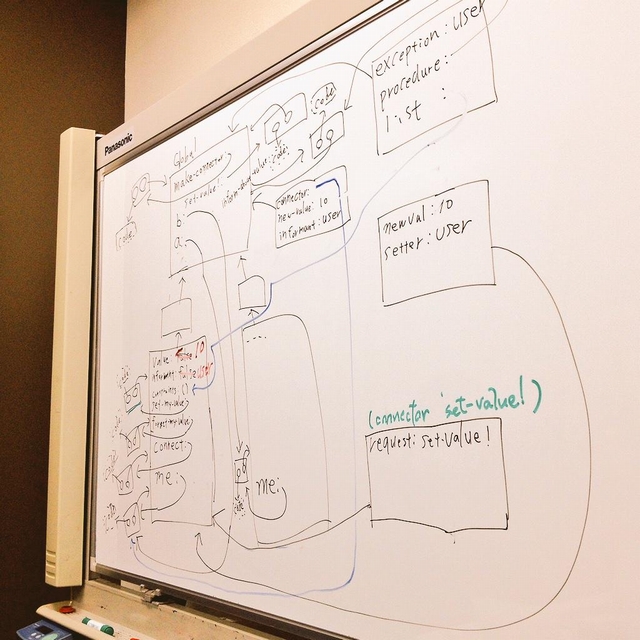今回のあらすじ
SICPの3.3.5 Propagation of ConstraintsのExercise 3.34からExercise 3.37までサクサク解いていきます。

Exercise 3.34
Louis Reasoner wants to build a squarer, a constraint device with two
terminals such that the value of connector b on the second terminal will
always be the square of the value a on the first terminal. He proposes the
following simple device made from a multiplier:
(define (squarer a b)
(multiplier a a b))There is a serious flaw in this idea. Explain.
adder や multiplier と同様に、squarer も一部のコネクター値が確定したら残りのコネクターの値を確定させることができます。
具体的には以下の2パターンがあります:
aの値が確定したら、その二乗をbに設定するbの値が確定したら、その平方根をaに設定する
Louis の squarer は前者には対応しているものの後者には対応していません。
multiplier は p * q = r の制約でしかないので、
3つのコネクターのうち2つの値が確定しないと残り1つの値を確定させることが(基本的には)できません。squarer が multiplier に同一のコネクター a を複数回使っていたとしても、
そのことを multiplier は知らない為、
Louis の squarer では平方根を求める事ができません。
Exercise 3.35
Ben Bitdiddle tells Louis that one way to avoid the trouble in exercise 3.34
is to define a squarer as a new primitive constraint. Fill in the missing
portions in Ben’s outline for a procedure to implement such a constraint:
(define (squarer a b)
(define (process-new-value)
(if (has-value? b)
(if (< (get-value b) 0)
(error "square less than 0 -- SQUARER" (get-value b))
<alternative1>)
<alternative2>))
(define (process-forget-value) <body1>)
(define (me request) <body2>)
<rest of definition>
me)adder や multiplier と同じパターンで書けばいいので楽勝ですね:
(define (squarer a b)
(define (process-new-value)
(if (has-value? b)
(if (< (get-value b) 0)
(error "square less than 0 -- SQUARER" (get-value b))
(set-value! a (sqrt (get-value b)) me))
(if (has-value? a)
(set-value! b (* (get-value a) (get-value a)) me))))
(define (process-forget-value)
(forget-value! a me)
(forget-value! b me)
(process-new-value))
(define (me request)
(cond ((eq? request 'I-have-a-value)
(process-new-value))
((eq? request 'I-lost-my-value)
(process-forget-value))
(else
(error "Unknown request -- SQUARER" request))))
(connect a me)
(connect b me)
me)Exercise 3.36
Suppose we evaluate the following sequence of expressions in the global
environment:
(define a (make-connector))
(define b (make-connector))
(set-value! a 10 'user)At some time during evaluation of the set-value!, the following expression
from the connector’s local procedure is evaluated:
(for-each-except setter inform-about-value constraints)Draw an environment diagram showing the environment in which the above
expression is evaluated.
こんな感じですね:

右上隅が for-each-except を呼び出す時に作られたフレームです。
Exercise 3.37
The celsius-fahrenheit-converter procedure is cumbersome when compared with
a more expression-oriented style of definition, such as
(define (celsius-fahrenheit-converter x)
(c+ (c* (c/ (cv 9) (cv 5))
x)
(cv 32)))
(define C (make-connector))
(define F (celsius-fahrenheit-converter C))Here c+, c*, etc. are the “constraint” versions of the arithmetic
operations. For example, c+ takes two connectors as arguments and returns
a connector that is related to these by an adder constraint:
(define (c+ x y)
(let ((z (make-connector)))
(adder x y z)
z))Define analogous procedures c-, c*, c/, and cv (constant value) that
enable us to define compound constraints as in the converter example above.
[33]
c+ の実装と同様にすれば良いので楽勝ですね:
(define (c- x y)
(let ((z (make-connector)))
(adder z y x)
z))
(define (c* x y)
(let ((z (make-connector)))
(multiplier x y z)
z))
(define (c/ x y)
(let ((z (make-connector)))
(multiplier z y x)
z))
(define (cv v)
(let ((z (make-connector)))
(constant v z)
z))しかし、制約システムの構築は面倒臭いものでしたが、このちょっとした変更だけで可読性が鰻登りです。
Schemeは凄いですね。
次回予告
3.4 Concurrency: Time Is of the Essenceをバリバリ読み進めます。
Exercise 3.38まで解けると良いかな……



